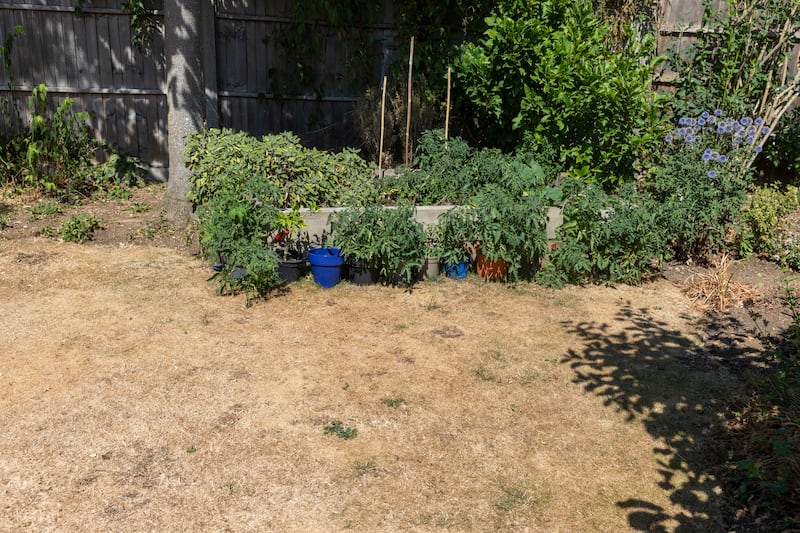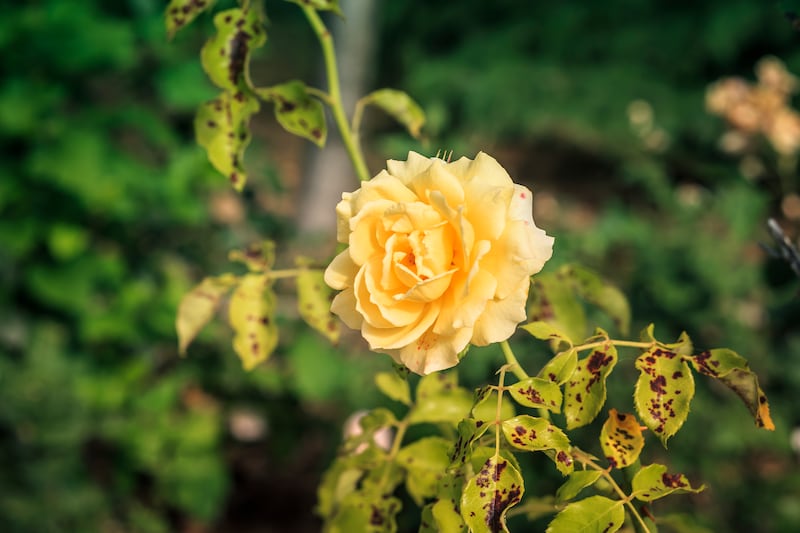There are lots of words that Irish gardeners could use to sum up the year that was 2023. “Wet” is certainly high on the list, given the record levels of rainfall experienced in most parts of the country from late summer onwards as well as the badly waterlogged state of many soils.
Odd as it may sound, “dry” is another, given the near drought-like conditions of much of spring and early summer. “Disappointing”, “frustrating” and “difficult” are also definitely up there. So are “peculiar”, and “unpredictable”, all of them expressive of the complex challenges increasingly confronting us as a result of climate change.
These same challenges are driving a seismic shift in the way we both want and need to garden in this strange new world of ours. As the country’s weather patterns become more extreme and less predictable, we are increasingly recognising the growing importance of gardening in ways that support and nurture the resilience of our gardens. So we are much more conscious, for example, of the pressing need to protect soil and plant health, as well as to foster biodiversity by respecting the myriad of life forms we share our precious patches of ground. For these reasons many of us are trying to be less tidy-minded, less fussy, less concerned with the pursuit of the ‘perfect’ garden, while at the same time be more thoughtful, more informed about the processes and possible consequences of our actions, as well as more willing to think outside the box.

The result is that traditional gardening chores that were once considered routine, such as the use of herbicides, pesticides and fungicides, weekly mowing of the lawn, weeding, strimming, hedge trimming, and regularly digging over the allotment or kitchen garden in preparation for planting, are no longer seen as such. Instead, we’re exploring other more nature-friendly ways of gardening. New approaches. Better methods that allow us to tread more lightly upon this precious planet.
Late-spring flowering plants can’t wait for summer to get started
Séan Moncrieff: ‘That’s a Tesla,’ my daughter said. ‘We don’t like them’
‘There were four girls raped in front of us. Their mother cried for their safety’
For a united Ireland to work messy compromises will be needed, but we can’t gift Irish identity to the far-right
The increasingly unpredictable nature of Irish weather patterns has also highlighted the need for flexibility and adaptability when it comes to tending our gardens and allotments. As one gardening friend said to me recently, “It feels like everything is shifting. Autumns are much milder and wetter, springs are drier, summers are hotter. All of it is having such a dramatic impact on our gardens and how we look after them.”
So what useful lessons can we take from 2023? I think the biggest is to be water-aware, from the threat of drought at key pressure points in the growing year to the potential damage to soil structure caused by flooding. Early summer’s blazing temperatures, for example, made it very difficult for young seedlings and transplants to establish vigorous root systems, putting huge pressure on gardeners to keep them sufficiently watered. In contrast, autumn’s frequent deluges made it next to impossible to get bulbs and young potted and bare-root trees and shrubs in the ground. The soil was so wet that it was also difficult for gardeners to find a suitable opportunity to mow traditional lawns or to give contemporary wild flower meadows their annual early autumn haircut. Heavy rainfall and sodden soils have also increased the threat of pests and diseases, from slugs and snails whose populations have soared in the damp, mild weather of recent months to the risk of destructive plant pathogens such as potato blight, tulip fire and phytophthora.
To mitigate these challenges, we will need to start reducing our reliance on labour-intensive, water-hungry annuals that struggle with such weather extremes and focus instead on much longer-lived, deeper-rooted plants like perennials, shrubs and trees that are naturally more resilient. The same goes for any of the more short-lived varieties of flowering bulbs that are so labour-demanding to get in the ground, and which require a decent interval of dry autumn weather for us to do so.

We will need to think more carefully about the plants we choose to grow in our gardens, basing that selection on their proven ability to cope with a wide range of growing conditions as well as their resilience to pests and diseases. Do you really, for example, want to keep growing a variety of rose that succumbs all too easily to black spot and mildew after a few weeks of wet summer weather, rather than one that has been carefully bred for its resistance to these common diseases? Or grow hostas that get eaten to shreds by slugs and snails? Is it time to finally rip out that once-beautiful box hedging that has been so decimated by the combined forces of box blight and box tree caterpillar that it is now a sad defoliated shadow of its former self? And is that Mediterranean-style mixed border perhaps a mistake given the extreme rainfall events of recent years?
Doing everything we can to prevent soil degradation will also be key to supporting the health of our gardens and allotments on the bumpy road ahead. As is true of all gardening, this needs to be a multipronged approach, from the use of organic mulches and green or “living” manures to act as a protective skin, to incorporating soil improvers such as well-rotted manure, home-made garden compost, leaf mould, biochar, Soil Renew, vermicompost and powdered seaweed to increase its water-holding capacity and stimulate beneficial soil microbial activity.
Innovative gardeners like Tanguy de Toulgoet of Dunmore Country School, Co Laois, are experimenting successfully with a holistic, no-dig approach to soil health and fertility that uses the French-Canadian technique known as BRF (bois raméal fragmenté) or, in English, RCW (rameal chopped wood). By spreading a mulch of finely-chopped, lignin-rich young/green woody branches and twigs of deciduous trees and shrubs on the ground to mimic the conditions found in natural woodlands, he is dramatically boosting populations of beneficial soil fungi and microfauna which are crucial to the process of turning organic matter into precious humus. The well-known English gardener Charles Dowding has also done a lot to popularise the no-dig approach, which protects the integrity and important functions of a healthy soil (not least of which is its ability to drain freely) by leaving its complex, biodiverse layers intact.
Making full use of the magic of modern garden tools and equipment is key. In a world of increasing climate extremes, I am eternally grateful, for example, for the protection that structures like polytunnels, glasshouses and cloches offer both to the plants that grow in them and the gardeners that tend them. Even a simple length of horticultural fleece, a modern miracle of technology, has the power to protect vulnerable baby seedlings from cold and wind as well as searing summer sunshine. All are reassuring proof of humankind’s enduring ability to devise endlessly ingenious solutions to the challenges that we will face in the tricky years ahead.
This week in the garden

This is a great time of year to start browsing seed and bulb catalogues and making lists of the varieties you would like to grow. But try to start the process with a realistic shopping list that takes account of your garden or allotment’s growing conditions and size, as well as the amount of time that you will be able to give to plants during the busy growing season.
Take advantage of any dry weather to walk your garden or allotment and make a to-do list of tasks that can be carried out at this quieter time of year, from essential repairs to garden structures to emptying old pots, clearing away old crops or bedding displays, and winter pruning.
Dates for your diary
Saturday, January 27th, Ballykealey House, Ballon, Co Carlow, Snowdrop Gala 2024. Guest speakers include Steve Edney of No Name Nursery in the UK and Michael Dreisvogt of Bonn’s Park Harle Arboretum in Germany, plus plant stalls from a hand-chosen selection of specialist nurseries. Tickets from €110 (early bird, book before January 13th, see altamontplants.digitickets.co.uk or email hesterforde@gmail.com).
Saturday, February 24th, Crowne Plaza Dublin Airport Hotel Conference Centre, Northwood Park, Santry, Dublin D09 X9X2, Space to Grow, the Garden & Landscape Designer Association’s (GLDA) 2024 seminar. Hosted by Stephanie Mahon, the Irish garden writer and editor of Gardens. This year’s event includes a stellar line-up of expert guest speakers from New Zealand, the Netherlands and the UK including Jo Wakelin, Giacomo Guzzon, Ton Muller, Stefana Marinaz, John Little and Mark Gregory. Tickets from €60-€140, see glda.ie.
- Sign up for push alerts and have the best news, analysis and comment delivered directly to your phone
- Find The Irish Times on WhatsApp and stay up to date
- Our In The News podcast is now published daily – Find the latest episode here














